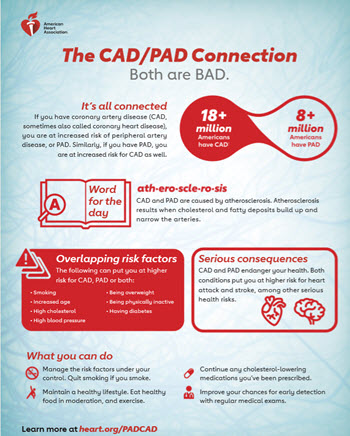Your feet, your heart: What’s the connection?
PAD and CAD: If you have one, you are at increased risk for the other
If you have coronary artery disease (CAD, sometimes also called coronary heart disease), you are at increased risk of peripheral artery disease, or PAD. Similarly, if you have PAD, you are at increased risk for CAD as well.

Download our CAD/PAD Connection infographic (PDF)
These two conditions have overlapping risk factors. The following can put you at higher risk for PAD and CAD:
- Smoking
- Increased age
- High cholesterol
- High blood pressure
- Being overweight
- Being physically inactive
- Having diabetes
Understand your risk factors
Smokers face the highest risk for CAD and PAD. Quitting smoking lowers your risk. In fact, it’s the best thing you can do for your overall health.If you have high cholesterol, be sure to continue any cholesterol-lowering medications (called statins) you have been prescribed. If prescribed, such medications are important for lowering the risk for heart disease and stroke. If you are living with CAD, PAD or both, you have a higher risk for heart disease and stroke.
Military veterans have been shown to have increased risk for PAD. This is because veterans tend to have higher-than-average blood pressure, along with higher rates of smoking and diabetes — all risk factors for PAD.
Veterans’ higher risk for PAD means that they have higher risk for CAD too.
A shared cause
Both CAD and PAD are caused by atherosclerosis. Atherosclerosis results when cholesterol and fatty deposits, sometimes called plaque, build up in the arteries.The resulting narrowing of the arteries is serious. The plaque that builds up in the arteries may cause a heart attack, and it puts you at risk for other dangerous conditions, such as stroke.
Management is possible
By minimizing the risk factors you can control, you can reduce your chances of experiencing CAD or PAD.
If you are living with CAD or PAD, you can lessen the impact of both conditions. Managing CAD and PAD relies on lifestyle changes, including proper diet and exercise, along with medications that your health care professional may recommend. In both cases, early detection is key to managing the disease.








